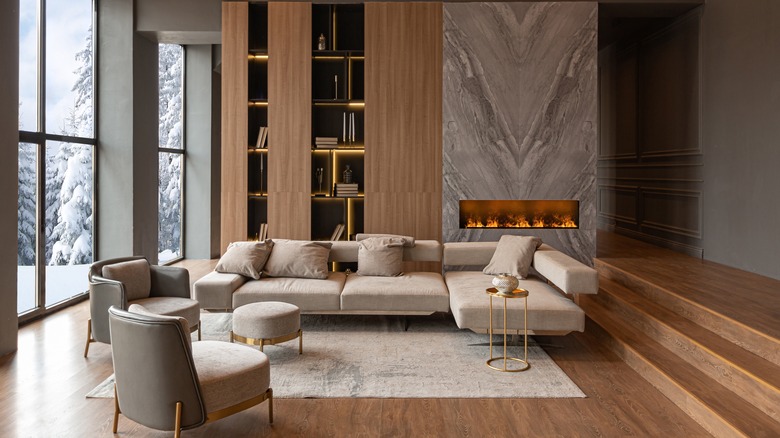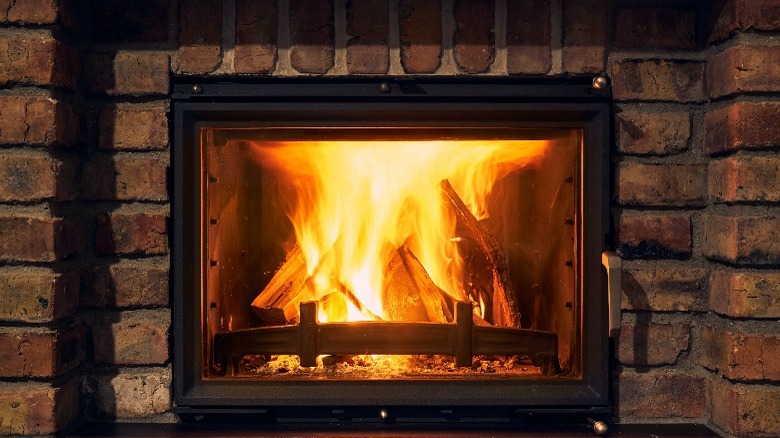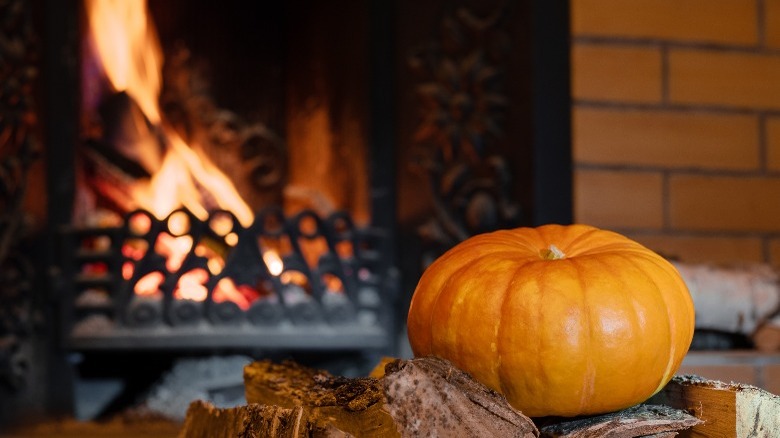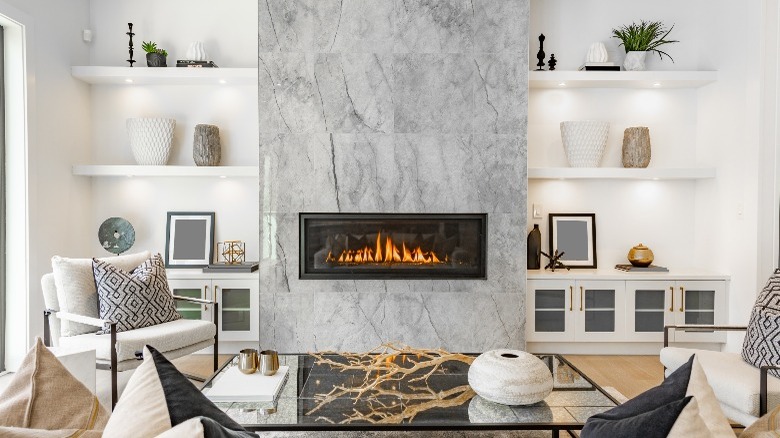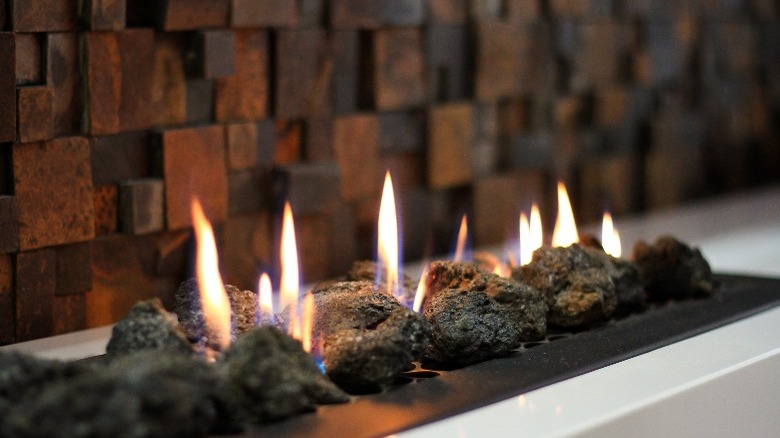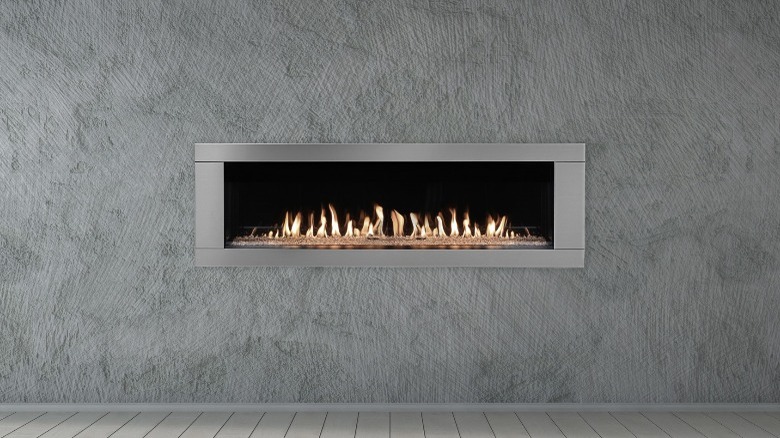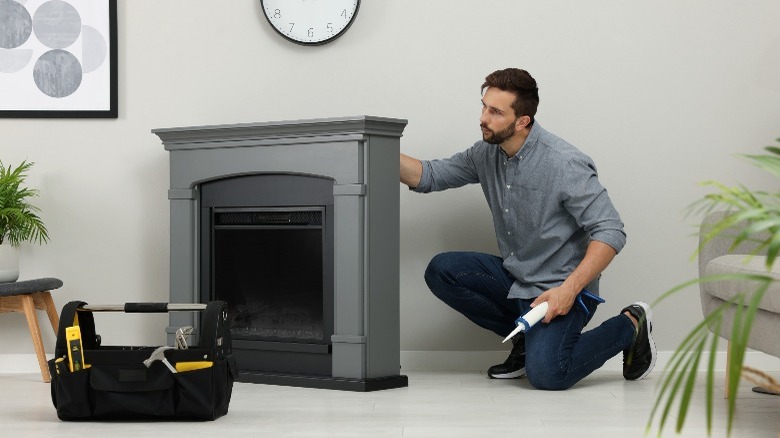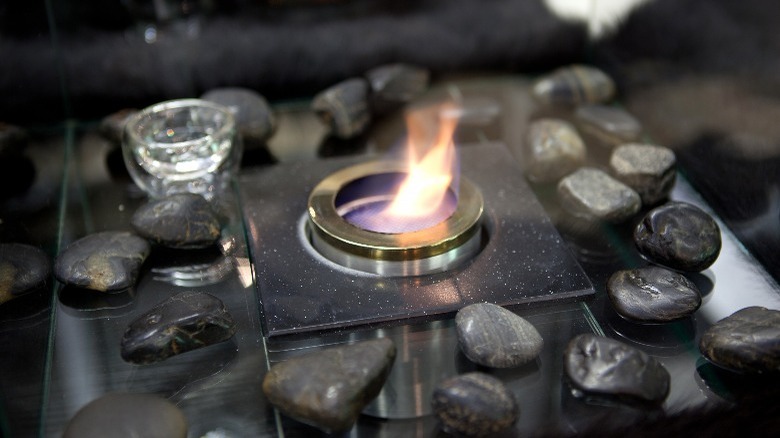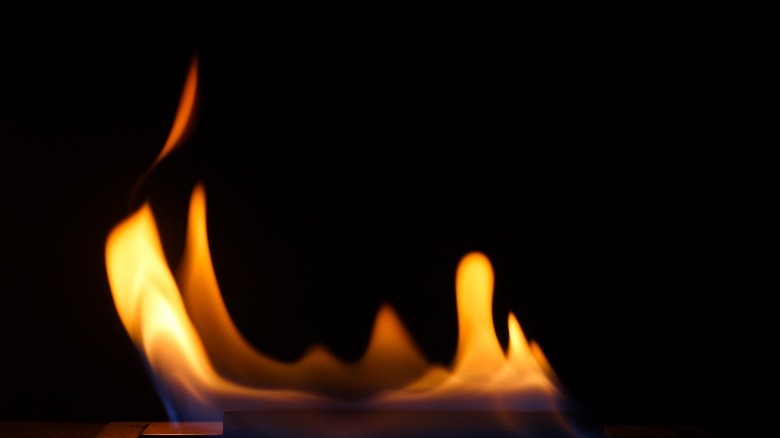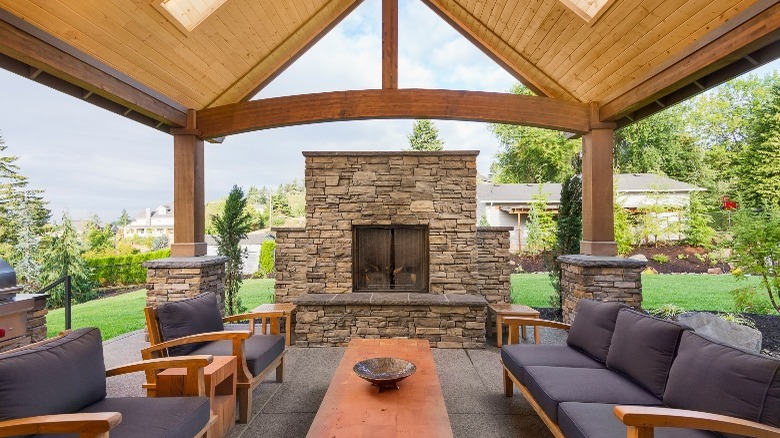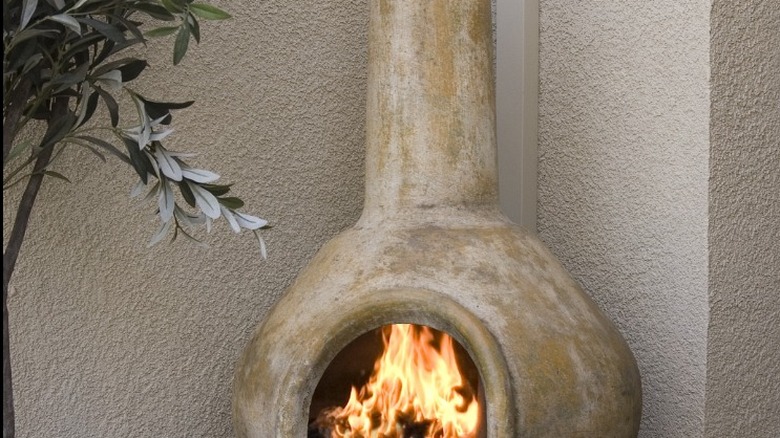What Are The Different Types Of Fireplaces?
Whether you're a lover of old-fashioned wood-burning fireplaces or want to enjoy a fire without the mess and hassle, there are multiple kinds of fireplaces out there to choose from. Luckily, whether you have an existing fireplace you want to renovate, or are thinking of installing one, Haley Comfort says most types are easier projects than we might think. A fireplace adds value to your home, so it's an improvement that makes good sense. And besides providing ambiance and a cozy gathering point for your family or guests, many fireplaces are a great alternative for affordable supplemental heat.
Quality Overhead Door explains several factors that will help determine which kind of fireplace is right for you. What type of fuel you prefer is one of the major points to consider. While many people might complain about wood-burning fireplaces, it is still the most inexpensive fuel to use. However, it's also the most difficult to maintain. If you want to renovate a current fireplace you rarely or never use, you may be surprised at all the different options available these days! Depending on your budget and personal preferences, there's likely a fireplace that makes sense for you. We'll go over all the different kinds, including indoor and outdoor selections, to help you make the most informed decision possible.
Traditional wood-burning fireplaces
Who doesn't love to sit by a crackling, roaring fire on a cold winter night with their sweetheart? Hanging stockings and putting out milk and cookies for Santa is another timeless family tradition. For many, there's just no substitute for wood-burning fireplaces, also often called open masonry fireplaces. There are many advantages to this kind of fireside, as Cutting Edge Firewood reminds us. As aforementioned, wood is the most inexpensive fuel for a fireplace, and if you use it to help heat your home, it's even more economical. Most people like the aroma of burning wood, and there are many different fragrances from different types of firewood you can buy.
There are additional things to keep in mind, however, if you're interested in adding a fireplace. Breakaway explains that wood-burning fireplaces require much more care, including keeping a supply of firewood, cleaning the fireplace often, disposing of the ashes regularly, and not leaving the fire unattended. This means that if you're planning to use your fireplace to help heat your home, you can only safely utilize it when you're there to monitor it. Still, for many people, there's just no substitute for a "real" wood-burning fireplace. After all, what's better than being able to roast marshmallows right in your own living room?
Wood fireplace inserts
So, what if you have an existing fireplace that desperately needs an upgrade? If you prefer the authentic wood-burning experience, Regency Fireplace Products recommends a wood fireplace insert. These consist of a sealed firebox that transforms your open fireplace into a highly efficient heating system at a fraction of the cost. One major problem with an open masonry fireplace is they're not efficient enough to use as an alternative heating method. However, with a wood fireplace insert, it generates. The insert is typically used with a blower, which pushes the heat more effectively into your home. To make it even more enticing, installation is easier because the existing masonry is used as the framework in conjunction with its chimney, transformed into the ventilation channel. The cost is more reasonable for both the product and the installation than a traditional fireplace.
R & T Services says some of the drawbacks to wood inserts are similar to the ones for a traditional wood-burning fireplace, such as higher maintenance and cleaning requirements. Also mentioned is the rapidly increasing cost of wood and the fact that you can only heat one room at a time. However, wood-burning inserts are the most fuel-efficient in terms of raising the temperature, and if you're in an area with frequent power loss due to bad weather, this type of insert is the smartest choice for you. But there are other fireplace inserts, as we will soon find out.
Gas log fireplaces and gas inserts
According to Hansen Wholesale, another option for transforming an existing masonry fireplace is converting it to a gas log fireplace. The gas logs are more realistic in appearance than they used to be and are crafted in various wood types, including birch, oak, and aspen. Of course, the higher-quality gas logs you purchase, the more realistic they appear. You can reduce your carbon footprint by burning natural gas or propane, and gas logs are much safer than wood logs, especially if you have children. Additionally, they're easier to use on-demand — using one is as simple as turning the switch on and off and adjusting the flame.
There are also other options within this category that include a variety of personal style preferences and can accommodate many different budgets. For example, there is the gas fireplace insert, which Miller Brick reports is for folks with an existing open-hearth fireplace interested in converting it to a gas-burning unit. Like wood inserts, gas inserts utilize the existing hearth and flue.
Gas fireplaces with direct vent systems
Woodland Direct notes that two of the most popular types of gas fireplaces you can get are direct vented systems or vent-free systems. With a direct vent fireplace, the system can be set up with or without a traditional chimney. These fireplaces use their own sealed vent and firebox solution, one that simultaneously pulls fresh air from outdoors for combustion, and pushes the exhaust gases safely outside the home either through a chimney or a pipe that reaches outdoors. This way, the air quality inside your home is maintained. To heat the room, the fireplace sucks in the cool air circulating around the firebox, then expels the warm air back out. You'll also enjoy the fire behind tempered glass for safety.
A co-axial venting system is the most common type used with direct vent fireplaces, and co-linear vent systems are used only in direct vent inserts. Co-axial systems can be used either vertically or horizontally and can be maneuvered in both directions when necessary to avoid wall supports such as joists or beams. In this manner, these gas fireplaces can be installed in any room in the house, regardless of where the flue is located. With higher-end units, certain manufacturers have special mounts for a television above them. These are typically found with units that have a heat-dump system installed, and thus need less clearance above the firebox. A heat-dump system simply takes the warmed air around the firebox and "dumps" the warm air into another room.
Gas fireplaces with ventless systems
For ventless gas fireplaces, Modern Blaze explains that this system is perfect for condos and homes without a pre-existing fireplace because they don't require a chimney or a flue to operate. They're also perfect for smaller homes looking for an alternative heating source, because these units can heat a larger area like a small house. This type of fireplace will need to connect to a gas line and electricity for igniting purposes, but it also will have a battery backup system in the case of a power outage.
However, it's important to note that there are areas where ventless fireplaces have been outlawed. California is one state, Washington D.C. has room restrictions, and certain cities in Illinois do not allow them. Since regulations constantly change, you must check your local building code guidelines before purchasing a ventless gas fireplace. They also will not be effective at high altitudes, so speak to a professional about what type of gas fireplace system is right for you.
Electric fireplaces
The next type of fireplace we will discuss is the electric mantel fireplace. Burning Log describes the electric fireplace as an electric heater that is made to appear as either an actual wood burning, coal burning, or natural gas burning fireplace. These units simply plug into the wall and can be used for heat or the appearance of flames, creating a cozy or romantic mood. They can provide heating for up to a 400 square feet area. Furthermore, there are several advantages to electric fireplaces over any other type. Most notably, of course, is the fact that they don't burn any fuel.
But there are many more, such as they can go anywhere, have little to no maintenance, and are easy to install. They're cheaper than any other type of fireplace, and safe for households with pets and children because it's safe to touch the glass surfaces. Electric fireplaces are also eco-friendly since they do not burn fuel or pollute the air indoors or outdoors. They don't require a venting system and can be installed in any home. They come in various colors and finishes, including stainless steel, oak, stone, mahogany, espresso, and black and white. Different manufacturers may offer other selections, so shop around.
Sub-types of electric fireplaces
According to Modern Flames, there are three main types of electric fireplaces to accommodate practically any location. These are wall-mount electric fireplaces, electric fireplace mantels, and electric fireplace inserts. An electric fireplace mantel has a ventless firebox with authentic-looking simulated flames like in a fireplace and a separate mantel that houses the firebox. Some of these models have mounting options, such as for media consoles, and others have shelving built in for a television or storage. A wall-mount electric fireplace is made to hang either from the wall or directly into the drywall, and comes with all the mounting hardware and instructions needed. Sometimes these models have restrictions, so check the building code for your location. Of course, electric fireplace inserts follow the pattern of other inserts as far as using your existing fireplace hearth, with a simple installation process. Infrared electric fireplaces are the high-end models in the electric fireplace category.
When it comes to electric fireplace kitchens, Fireplace Universe says they're no good in a power outage, which is one of the advantages of other types of fireplaces in cold weather. Furthermore, they're not a very authentic experience where fireplaces are concerned, lacking smells, sounds, and even an unrealistic appearance in many cases. These things, combined with the fact that they do not have serviceable parts and a shorter life expectancy, make for a valid argument against electric fireplaces. However, they can be, in some cases, the only option available to those who crave that fireplace experience. These units can even be used in an apartment, and have come a long way in appearance.
Ethanol fireplaces
Modern Blaze helps us with ethanol fireplaces, also called bio-ethanol or just plain bio fireplaces. Ethanol fireplaces make a great option because they burn alcohol-based, clean fuel that does not produce harmful vapors, so they don't require a chimney or flue. It's a ventless system that can be installed nearly anywhere and has real flames. This type of fireplace is quite unique since it comes in table-top or free-standing versions, and creates the appearance of a flame coming directly out of a table or wherever you put it. To use it, you pour the ethanol fuel straight into the burner and light it with a long lighter (and safety goggles). Some selections include electronic components for remote starting. They are easy to assemble, display, and use and have a surreal look.
There are also bigger units that take a little more assembly, such as the wall-mounted unit, but they are no more difficult than mounting a television or flatscreen. You can also customize them for your own DIY home project that might include a fire pit, fire table, or fireplace. There are also ethanol firebox units that have a stainless steel insulated box around the ethanol burner. Of course, they work in power outages as well. The cost of ethanol is quite expensive compared to other fuels, however, costing approximately $2.50 an hour. Ethanol Fireplace Pros lists some further disadvantages, such as that although they provide some heat, they do not give off much — especially compared to other fireplaces. They can present a risk if you spill the fuel on anything, and you will need to ensure airflow since ethanol, like any flame, consumes oxygen in the air around it.
Gel fireplaces
Gel fireplaces are similar to ethanol fireplaces, but are simply a type of fireplace that burns a different fuel. According to Green Garage, instead of ethanol, gel fireplaces — also called bio fireplaces — burn a gel made from an isopropyl alcohol mixture that comes in a can, which can be purchased at home improvement stores for around $3. A can typically last for about two to three hours, so as you can see, the cost is quite a bit less than ethanol. However, the units are typically set up to handle up to three cans simultaneously, in which case the fuel cost would increase by quite a lot! For a bit more money, some gel fuel comes with popping and hissing sounds to mimic a real wood-burning fire, and to extinguish the flames, you slide the lid back onto the can.
Like ethanol fireplaces, freestanding gel versions can be placed anywhere — they require nothing but a well-ventilated area. They have several other models, including wall mounts and outdoor fireplaces. Like an ethanol fireplace, gel fireplaces do not put out much heat. For example, gel fireplaces put out approximately 3,000 BTUs per can. When burning well, a wood-burning fire puts out about 40,000 BTUs, and a gas fireplace can get up to around 65,000 BTUs. So, you can easily see the difference there.
Furthermore, gel fireplaces are not odor-free, and though slight, a liquor smell burns off. Some gels that pop and hiss also have an odor that is detectable when burning. You cannot adjust the flame level, and they have inherent safety risks. They do work without power, but do not put out enough heat to be an economical choice during outages.
Outdoor fireplace kits and inserts
You can buy an outdoor fireplace kit and customize it to your specific needs and design. This way, you can build a beautiful stone masonry fireplace to match your custom outdoor design plan. Of course, most people hire a contractor, but it's possible to DIY. You can also buy portable, stand-alone fireplaces designed for outdoor use, but where's the fun in that? Just kidding, we cover those below. For now, let's learn something — like what exactly they consist of.
Typically, outdoor fireplace kits are compared to masonry kits that contain pre-engineered blocks that you put together with mortar, forming a basic fireplace and chimney system that can also be easily customized. The reason outdoor fireplace kits are compared to masonry-type builds is that other outdoor fireplace units are typically portable. These kits usually cost about ⅓ of a traditional brick-and-mortar fireplace and can be installed indoors in a new construction home.
Portable outdoor fireplaces
Last but not least are portable outdoor fireplaces. According to HGTV, this is an option to consider if you love being able to entertain or gather with family in an outdoor living area around a fire, but don't want to invest the time and/or money in an outdoor kit. Today, there are so many different options and styles for these prefabricated fireplaces that you'll want to look online to find the type you want. Contemporaneously, you'll want to be sure to have a spot picked out with no hanging trees or bushes nearby, or anything overtly flammable.
Using a fire-resistant mat underneath your portable fireplace is also recommended, especially if using it on a patio, deck, or near dry grass. A portable outdoor fireplace is available in different veneers like ceramic, metal, brick, and stucco. You will also have the same decision to make regarding the type of fuel you want to burn in your outdoor fireplace. Chimineas are just one unique outdoor fire feature idea — there are literally hundreds! With so many different models, design choices, and fuel options, we hope you'll now be able to make a better-informed decision regarding the one that's right for you. Besides, adding a fireplace is the hot new home improvement trend — with installations that are through the roof!
